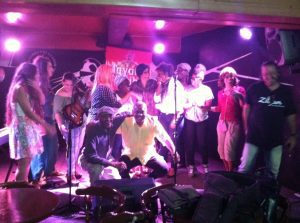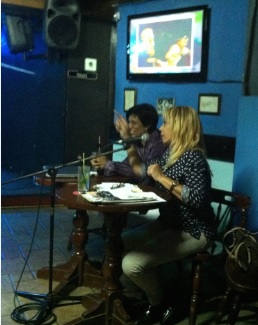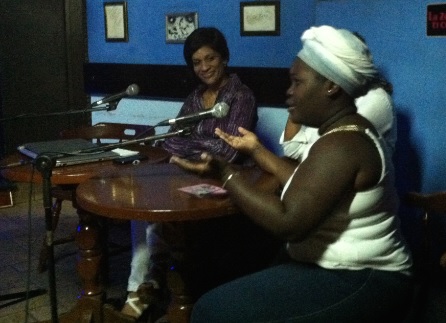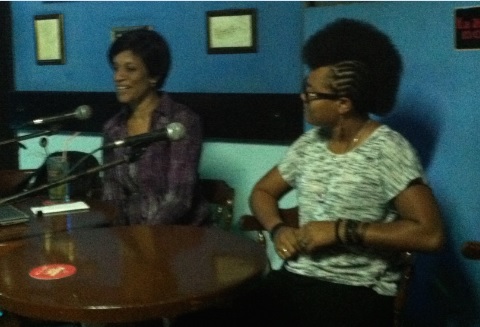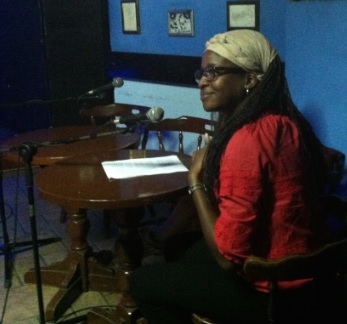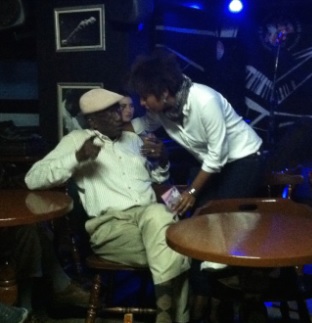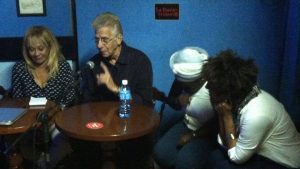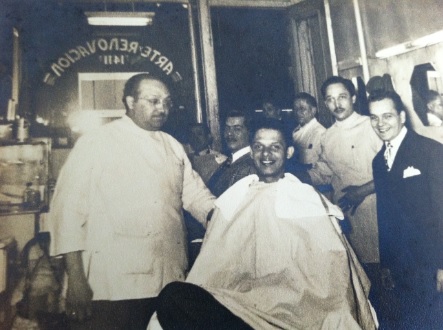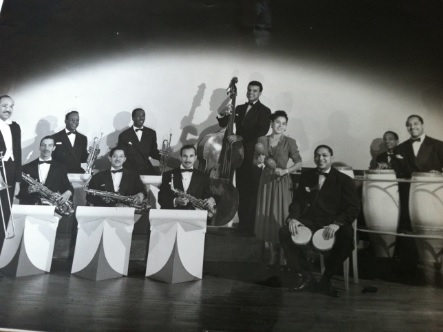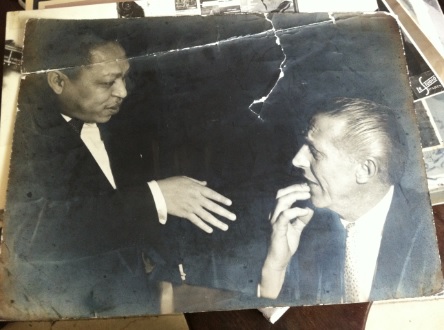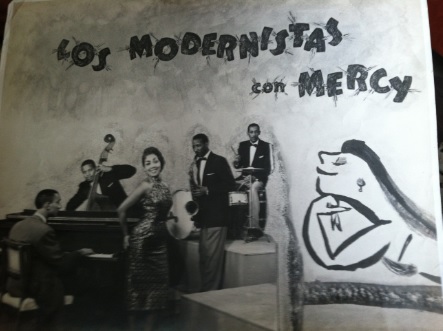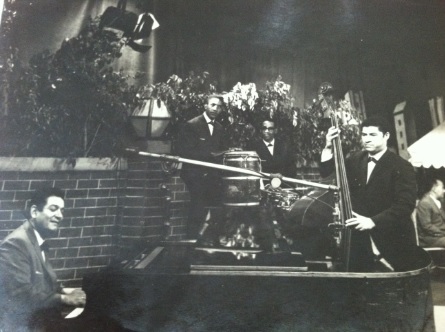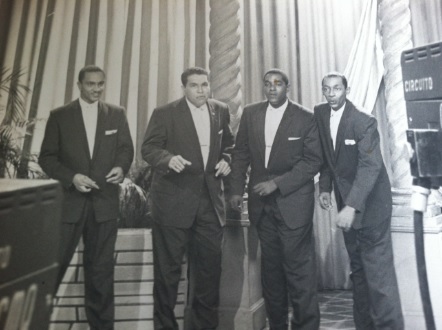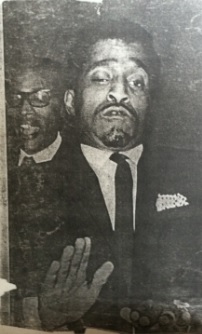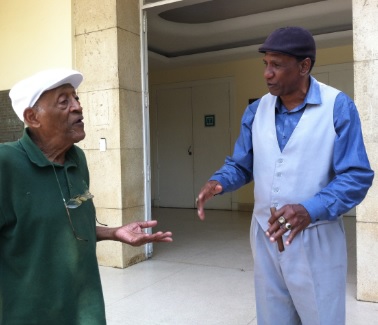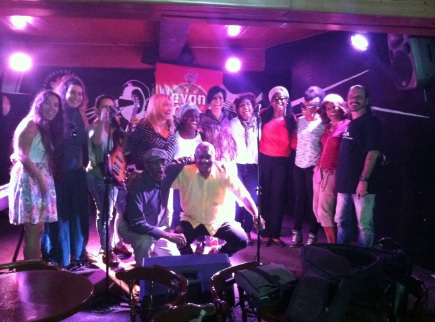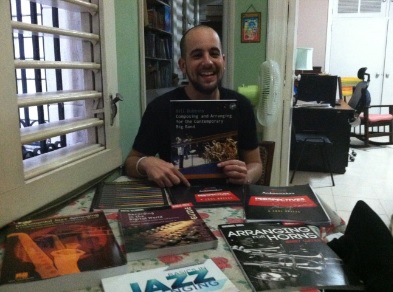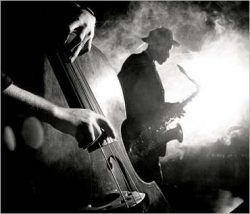Afro-Cuban culture, Blog, Cuba, Travel to Cuba, Video and audio
Not all the music in Cuba is in formal venues.
A few blocks from where I was staying I came across this band.
They got together to accompany an outdoor basketball tournament taking place in in public park.
In the last video the guys identify themselves and the name of the band.
A Saturday morning surprise on Calle 23 in Vedado
Note the little kids watching. This is how the music gets transmitted to the next generation.
Snare, bass drum, trumpet, cow bell. These guys would be at home in New Orleans. Was this one of the sounds of Congo Square?
On days like this, I wish my Spanish was better
These videos are just the tip of the tip of the iceberg of what I saw and heard in Havana. Over the ten days there I went to at least two different shows, some days as many as five, per day.
I could have easily gone to more and I never saw a bad one.
– Ken McCarthy
Jazz on the Tube
P.S. Our unique programming is made possible by help from people like you. Learn how you can contribute to our efforts here: Support Jazz on the Tube
Thanks.
Go to Cuba with Jazz on the Tube as your guide:
Click here for details
Afro-Cuban culture, Blog, Cuba, Festivals, Video, Video and audio
If you’re looking for a great time to visit Havana, keep your eyes open for the Fiesta del Tambor which takes place every March.
This festival literally offers more music at more locations than any mere mortal could possibly absorb.
I focused on three of the five venues, all of which are relatively close to each other: The Riviera Hotel (you’ve seen fragments of some of the jazz sessions there), Teatro Malla and Jardin de Teatro Malla.
The first four videos are from the Jardin (the garden.)
The last one is from a stage show inside the theater.
Proyecto Mujeres de la Rumba takes the stage.
In Cuba it’s not a surprise to see an audience member join in with complete knowledge of the moves and songs.
Los Papines, a decades old rumba group in its latest form
More from Los Papines
In Cuba, everybody dances: Alain Perez and friends
Keep in mind there was a different stage show at the Mella every night of the Festival and two rumba groups in the garden afterwards every night.
In spite of these musical riches, not everything interesting took place in a theater or garden or as part of the Festival.
Here’s what I stumbled across at a kid’s basketball tournament.
– Ken McCarthy
Jazz on the Tube
P.S. Our unique programming is made possible by help from people like you. Learn how you can contribute to our efforts here: Support Jazz on the Tube
Thanks.
Blog, Cuba, Cuban Jazz, Latin Jazz, The Cuba-US connection, Travel to Cuba, Video and audio
By marvelous coincidence, Fiesta del Tambor coincided with Cuban Women in Jazz Week.
El Zorra y La Cuarva, Havana’s pre-eminent jazz club, featured a different woman-led band every night during the week of March 6.
The truth is this scheduling only required a little rearranging of Zorra’s schedule since all of these bands already play there regularly when they’re in the country.
On Wednesday, March 8, International Woman’s Day (a holiday which began in NYC in 1909), the club hosted an all day conference on women in jazz in Cuba.
After a day of fruitful and enlightening discussion, the featured bandleaders got on stage with no rehearsal of any kind, someone called the tune “Besame Mucho” and this resulted.
Apologies to the bass player whose solo got cut off midstream. I ran out of memory and had to jettison files before I could start filming again.
 The whole gang.
The whole gang.
Click on the photo to enlarge it Bellita (Lilia Esther Exposito Pino), bandleader, composer, educator, pianist extraordinaire and organizer of
Bellita (Lilia Esther Exposito Pino), bandleader, composer, educator, pianist extraordinaire and organizer of
women’s week in jazz Singer, composer and bandleader Daimé Arocena
Singer, composer and bandleader Daimé Arocena Drummer and bandleader Yissy Garcia. Her band is BandAncha
Drummer and bandleader Yissy Garcia. Her band is BandAncha A musicologist discusses the rich history of all-woman singing groups in Cuba
A musicologist discusses the rich history of all-woman singing groups in Cuba Singer and band leader Zule Guerra talks with Cuban jazz veteran saxophonist and bandleader Rafael Quiñones
Singer and band leader Zule Guerra talks with Cuban jazz veteran saxophonist and bandleader Rafael Quiñones Legendary jazz singer Bobby Carcassés talks about scat singing with three of Cuba’s top practitioners Bellita, Daimé Arocena, and Zule Guerra
Legendary jazz singer Bobby Carcassés talks about scat singing with three of Cuba’s top practitioners Bellita, Daimé Arocena, and Zule GuerraNow let’s go to the event that brought us to Havana in the first place: Fiesta del Tambor, Festival of the Drum.
– Ken McCarthy
Jazz on the Tube
P.S. Our unique programming is made possible by help from people like you. Learn how you can contribute to our efforts here: Support Jazz on the Tube
Thanks.
Blog, Cuba, Cuban Jazz, Latin Jazz, The Cuba-US connection, Travel to Cuba, Video and audio
We went down to Havana in March to see the Fiesta del Tambor (The Drum Festival.)
We figured a drum festival in Havana had to be amazing, but nothing prepared us for the superabundance of talent and the sheer amount of music offered.
Since Jazz on the Tube is a jazz web site, we’re going to start with the jazz we encountered, but follow the thread to the end to get a more complete picture of this Treasure Island of music, both in and outside the festival.
At the Riviera Hotel, Havana
March 2017
Oliver Valdes – leader, drummer
Alejandro Delgado – trumpet
Tony Rodriquez – piano
Jorge Reyes – bass
Marcus Santos – congas
Did you recognize the tune?
It’s “Chan Chan” a 1987 composition by Compay Segundo featured in the movie “The Buena Vista Social Club.”
This is a great example of the alchemy jazz can accomplish, taking a well known melody and finding deeper magic in it. (Think John Coltrane’s version of “My Favorite Things.”)
At the Riviera Hotel
March 2017
Delvis Ponce Jove – leader, alto saxophone
Carlos Vietia – saxophone, trumpet
Michael Herrera – saxophone
Miguel Garcia – piano
Victor Cambel – piano
Edwardo Silveira – congas
Karel Kindelan – drums

Delvis Ponce Jove talks with a mystery man. Click here to discover who he is
– Ken McCarthy
Jazz on the Tube
P.S. Our unique programming is made possible by help from people like you. Learn how you can contribute to our efforts here: Support Jazz on the Tube
Thanks.
Artist-Educators, Blog, Cuba, Cuban Jazz, Latin Jazz, The Cuba-US connection, Travel to Cuba
Gilberto Valdés is eight-eight years old this year. We had the wonderful opportunity to meet him and spend some time talking jazz.
Jazz drummer, singer, band leader, producer and educator. Gilberto’s life tells the story of post-war jazz in the United States and Cuba and bridges Cuba’s pre and post-Revolution jazz history.
Havana-born, as a five year old he was introduced to American jazz by his young uncle, Raul Zequeira, who was just nine years older than him. During his childhood Gilberto accompanied his uncle to many parties and social gatherings where American jazz and pop music was au courant.
Later as a young man, Gilberto made frequent trips to New York City where he stayed with his step-father, Humberto Gelabert, a former sideman with Benny Carter and the bandleader of his own Cuban orchestra. Humberto also owned a popular barbershop in East Harlem.
During these trips, Gilberto went to the Savoy Ballroom, Minton’s (where he sat in one night), Birdland, and the Palladium Ballroom.
What he learned, he brought back home and among other things helped pioneer bebop on the island.
In 1957, while his vocal quartet “The Cavaliers” was performing at San Souci, the preeminent nightclub in Havana, he met Roy Haynes who at the time was the drummer in Sarah Vaugh’s Trio. Haynes gave Gilberto a set of drum sticks as an encouragement to take up the drums, which he did.
He spent the first half of the sixties in Europe where he reconnected with his Uncle Raul who had moved to Paris after World War II and had his own band.
When Gilberto returned to Cuba he became the country’s jazz ambassador hosting Dizzy Gillespie’s historic 1977 visit, bringing the Cuban super group Irakere to the U.S. and representing Cuban jazz musicians internationally.
As the last picture in this series shows, he’s a beloved figure in Havana’s jazz scene where he’s been an educator and mentor to countless young jazz musicians.
Along with pianist and bandleader Bellita, he played a key role in saving Cuba’s most important jazz club El Zorra y La Cuarva from being turned into a pizzeria!
Photos
 Gilberto’s step-father Humberto Gelabert (on the left) was
Gilberto’s step-father Humberto Gelabert (on the left) was
proprietor of a barbershop in East Harlem Gilberto’s step-father and his Cuban jazz orchestra
Gilberto’s step-father and his Cuban jazz orchestra
He’s on the far left with a trombone Gilberto’s step-father talking with Stan Kenton
Gilberto’s step-father talking with Stan Kenton Gilberto’s band brought modern North American jazz to Cuba.
Gilberto’s band brought modern North American jazz to Cuba.
That’s Gilberto on drums on the upper right Gilberto started as a professional singer in high school specializing in Harmonical Vocal Quartet music and continued with singing groups his entire career. Gilberto is on the far right.
Gilberto started as a professional singer in high school specializing in Harmonical Vocal Quartet music and continued with singing groups his entire career. Gilberto is on the far right. Gilberto on drum kit
Gilberto on drum kit A television pioneer in Cuba. Gilberto on the far right
A television pioneer in Cuba. Gilberto on the far right A publicity shot from the White Elephant in Paris in the 1960s.
A publicity shot from the White Elephant in Paris in the 1960s.
Gilberto on timbales Gilberto on drums with Bebe Valdés in Sweden in the 1960s
Gilberto on drums with Bebe Valdés in Sweden in the 1960s Sammy Davis Jr. on congas and Gilberto on timbales
Sammy Davis Jr. on congas and Gilberto on timbales Gilberto (with tie) brought Irakere to New York City and the world.
Gilberto (with tie) brought Irakere to New York City and the world.
Chucho Valdés on the left. The President of CBS’s Record Division Bruce Lundwald on the upper right. Conga player Oscar Valdés (no relation) on the lower right In front of Casa de la Cultura de Plaza, the birthplace of the Havana Jazz Festival, Gilberto with youngest son of Jorge Varona, who played with Irakere during Irakere’s visit to US
In front of Casa de la Cultura de Plaza, the birthplace of the Havana Jazz Festival, Gilberto with youngest son of Jorge Varona, who played with Irakere during Irakere’s visit to US Gilberto with special friends – March 2017.
Gilberto with special friends – March 2017.
Up front, to the left of the man in yellow, Waldo Nelson Cárdenas
of the Havana jazz club El Zorra y La CuervaTo find out who these special friends are, click here.
– Ken McCarthy
Jazz on the Tube
P.S. Our unique programming is made possible by help from people like you. Learn how you can contribute to our efforts here: Support Jazz on the Tube
Thanks.
Blog, Cuba, Cuban Jazz, Latin Jazz, The Cuba-US connection, Video and audio
 Camilo Moreira our heroic educator in Havana
Camilo Moreira our heroic educator in HavanaJazz has been in Cuba for almost as long as jazz has existed. In fact, Cuban music was one of the contributors to the formation of jazz in its earliest years. (See Jelly Roll Morton’s comment on the essential role of the “Spanish tinge” in achieving the jazz feel.)
In spite of this long history, being a jazz musician in Cuba has not been easy for the last 55+ years since the free flow of audiences, musicians, records, and scores was cut off.
Cubans have extremely limited access to the Internet and the world market price of a single CD is the equivalent of a full week’s salary for them. Books, scores, and travel are correspondingly expensive and difficult to arrange.
While Cuba has an outstanding system for education in classical music (one of the best in the world), jazz education is carried out largely outside the academy and with little to no financial support.
How then does Cuba manage to produce so many world class jazz musicians?
Individual initiative and the passion and dedication of the country’s jazz community.
Growing the next generation of Cuban jazz musicians
Fledgling jazz musicians need the chance to learn their instruments, play with others, and master the theory that underpins the music.
One of the key figures in making these opportunities available to young people in Cuba today is Camilo Moreira, a friend of Jazz on the Tube.
A fine guitarist who has shifted his focus to education and composition, Camilo is a summa cum laude graduate of the Cuba’s top performing arts school University of the Arts (ISA) where he was recognized by the faculty as the best student-teacher of his graduating class.
Since 2010, he’s been teaching harmony, composition, computer music and ensemble practice at the country’s top conservatory for secondary students, the National School of Music (ENA). He also directs the school’s jazz band which was recently invited to perform at Jazz at Lincoln Center in April of 2016.
This year (2017), Camilo has taken on the important task of reviving and directing ISA’s Jazz Band. This is easily the most important jazz education initiative in the country.
How you can to help
As you can see from the picture above, Camilo likes books on composing, arranging and theory. They’re treasures to him.
For any of us, getting books on any subject is a simple matter of going to Amazon, spending a few bucks, and clicking send.
But there is no Amazon for Cubans and even if there were, a single music text can cost Camilo the equivalent of a month’s salary or more.
Up until now, that’s how he’s gotten his books, painstakingly saving his money and acquiring them catch-as-catch-can.
No more.
Jazz on the Tube has asked Camilo to give us his shopping list of the books he needs to continue his work as a teacher, arranger and composer.
We’re also on the lookout for scores and charts from, especially but not limited to, Machito and Mario Bauza, Tito Puente, Pérez Prado, and others who brought Cuban music into big band settings.
If you’re a promising young musician in Cuba, as a secondary student, you’re in ENA and as a university student, you’re in ISA. In both places Camilo is the face of jazz and we want to help him in his mission every way we can.
The power of positive leverage
It’s rare in life that such modest inputs (books and other support) have the potential to have such an oversized output.
If you’d like to be part of this project, please include a note to that effect with your next contribution to Jazz on the Tube and we’ll make sure the money you send is used for the purpose of supporting jazz education in Cuba.
By the way, in addition to being a first rate educator, Camilo is also an accomplished composer and arranger.
Using the old “sneaker net” method – flash drives passed from hand-to-hand instead of the Internet which as stated before is not easily accessed in Cuba – we’ve put some of his work online for you to enjoy.
Support Jazz on the Tube’s education projects in Cuba
Camilo wrote the score for the Cuban-made feature film “La Isla de Corcho” (“Cork Island”)
A Camilo Moreira composition and arrangement sung by Luna Manzanares: “Dejo Una Cancion”
Camilo Moreira wrote this one too: “El Trapezio de La Luna” Performed by friends and classmates from ISA. (A first reading.)
– Ken McCarthy
Jazz on the Tube
P.S. Our unique programming is made possible by help from people like you. Learn how you can contribute to our efforts here: Support Jazz on the Tube
Thanks.

